SOY MYTHS & FACTS
Soyfoods are common in Asian and many health-conscious western diets, thus it is pertinent to explore the safety of soy as documented in the body of accumulated research. Consumers can be encouraged to continue feeding their families soyfoods for generations to come.
Introduction
Interest in the protective effects of soyfoods against breast cancer began three decades ago1 and can be attributed primarily to two observations. The first observation is the historically low breast cancer mortality rates in soyfood-consuming Asian countries.2 The second observation is the potential for soybean isoflavones to function as anti-estrogens.3 Foods made from soybeans are uniquely rich sources of isoflavones, which are diphenolic, nonsteroidal molecules.4 These soybean constituents are classified as both phytoestrogens and selective estrogen receptor modulators (SERMs).5
SERMs can function as estrogen receptor (ER) agonists, ER antagonists or have no effects at all in tissues that possess ERs. The preference for isoflavones to bind to and activate ERββ in comparison to ERαβ is thought to account for their SERM-like properties.5 When activated, these two receptors can have very different and sometimes even opposite physiological effects. For example, in the breast, activation of ERββ is thought to inhibit the proliferative effects of ERα activation.6 In contrast to isoflavones, estrogen has equal affinity for both receptors.
Epidemiologic research indicates soy consumption is associated with an approximate one-third reduction in risk of developing breast cancer.7 However, several lines of evidence suggest that for soy to reduce breast cancer risk, consumption must occur during childhood and/or adolescence. Case-control studies indicate that the consumption of just one to two servings of soy during this period may reduce breast cancer risk by as much as 60 percent.8-10 Isoflavones appear to change the cells in the developing breast that makes them permanently less likely to transform into cancer cells. The notion that early soy intake reduces breast cancer risk is consistent with current understanding that exposures and events during the first 20 years of life profoundly impact risk of developing breast cancer.11
Despite the proposed breast cancer preventive effects, there has been concern that soyfoods, because they contain isoflavones, worsen the prognosis of women with breast cancer and increase the risk of developing breast cancer in women who are at high risk for this disease. The soy breast cancer controversy is based almost exclusively on a series of rodent studies that began to be published in the late 1990s, which showed that isoflavones stimulate the growth of existing estrogen-sensitive mammary tumors in athymic ovariectomized mice.12,13 Of the three isoflavones in soybeans, genistein, daidzein and glycitein, it is primarily genistein that stimulates tumor growth in this model.
There are well-known limitations to animal studies but in the case of soy-related research, rodents appear to be of especially limited value for providing insight about soyfoods because they metabolize isoflavones so differently than humans.14 Furthermore, it was shown in 2011, that just slightly tweaking the above referenced athymic ovariectomized rodent model in what is an arguably a more physiological direction, causes a complete loss of the tumor-stimulatory effect of genistein.15
Traditional soyfoods have played an important role in Asian diets for centuries and been consumed by health-conscious individuals in Western countries for many decades. Soyfoods have become increasingly popular among mainstream consumers in the West. Nevertheless, soyfoods are not without controversy. Concerns have arisen that soy may exert adverse effects in some individuals.
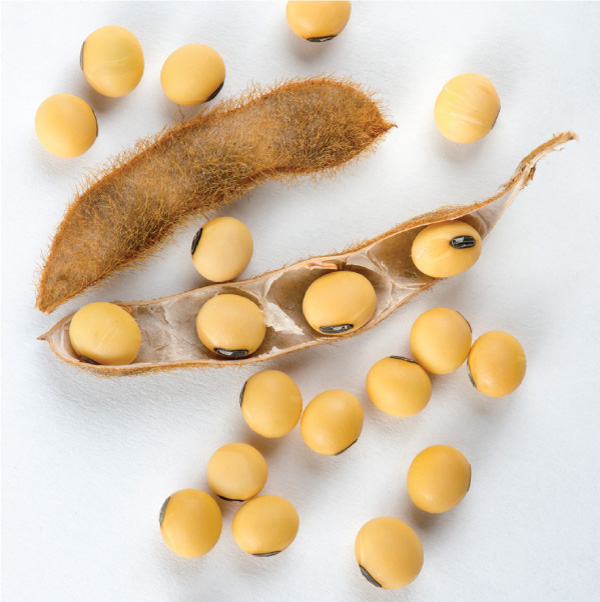
Many of the concerns can be attributed to the uniquely rich isoflavone content of soybeans and studies conducted in animals. However, the totality of the clinical and epidemiologic research shows these concerns are without scientific merit – as discussed in the text below. Health agencies and academic groups that have reviewed the data are in support of this conclusion.
| 1999 | As part of the process for approving the soy protein and coronary heart disease-health claim, the U.S. Food and Drug Administration (FDA) concluded that soyfoods are safe for all, except those who are allergic to soy protein.1 |
| 2005 | The Agency for Healthcare Research and Quality identified only minor problems associated with the intake of large amounts of soy, such as mild gastrointestinal disturbances.2 |
| 2009 | A meta-analysis conducted by Austrian researchers, which was undertaken specifically to address the safety of isoflavone supplements, concluded they have a safe side-effect profile.3 |
| 2012 | The American Cancer Society4 and the American Institute for Cancer Research5 concluded that women with breast cancer can safely consume soyfoods. |
| 2015 | Health Canada approved a health claim for soy protein and coronary heart disease similar to the 1999 U.S. claim. After extensively reviewing the scientific literature, Health Canada concluded that soy consumption was associated with only minor
side effects, mostly gastrointestinal in nature.6 The European Food Safety Authority concluded that isoflavones do not exert adverse effects on the three tissues evaluated, the breast, uterus and thyroid.7 |
| 2017 | As part of its reevaluation of the soy protein health claim, the FDA reconfirmed its position that soy protein is safe.8 |
| 2018 | In a joint report, the American Institute for Cancer Research and the World Cancer Research Fund concluded post-diagnosis soy intake may improve the survival of women with breast cancer.9 |
Soy Consumption
Many Asian dietary surveys have been published over the past 25 years, some involving thousands of individuals that have included detailed questions about soy consumption. These surveys make several clear, important points. The first being that soy consumption among Asian countries varies quite markedly. Japan is at the high-end of the spectrum whereas Hong Kong is at the low-end. The second point is that most soy consumed throughout the world is unfermented.10
The best indicators of soyfood intake are the amount of soy protein and isoflavones consumed. Because there are approximately 3.5 mg isoflavones per gram protein in traditional soyfoods, soy protein intake can be estimated from isoflavone intake and visa versa. This ratio will not apply to some refined soy products because the processing used in their making can cause as much as 80 percent of the isoflavone content to be lost.
In Japan, the daily intake of soy protein by older individuals is approximately eight to 10g, which represents about 10 percent of their total protein intake.10 Isoflavone intake ranges from about 30 to 50 milligrams per day (mg/d).11 Chinese soy intake varies markedly among regions.12 Large studies from Shanghai, a high-soy-consuming area, indicate men consume anywhere from about nine to as much as 13 g of soy protein per day,13 the latter figure representing about 15 percent of total protein intake.14 Shanghainese women consume about 9 g soy protein per day.15 Individuals in the upper quarter of intake consume about 15 to 20 g soy protein daily. Approximately 1.5 servings of a traditional soyfood provides about 10 g soy protein since one serving provides about 7 g protein, although some soyfoods can provide considerably more than this amount. In Korea, the national survey, which involved over 11,000 healthy adults ≥19 y, revealed that mean isoflavone intake was approximately 24 mg/d.16
In Japan, approximately half of the soy consumed comes from unfermented foods, with four foods – tofu, miso, natto and fried tofu – accounting for about 90 percent of all soy consumed.11,17,18 In contrast, in Shanghai, and throughout much of China, nearly all of the soy consumed is unfermented as soymilk, tofu. Processed soy products other than tofu account for about 80 percent of total soy consumption.19 In Korea, about 70 percent of the soy consumed is in unfermented form.20
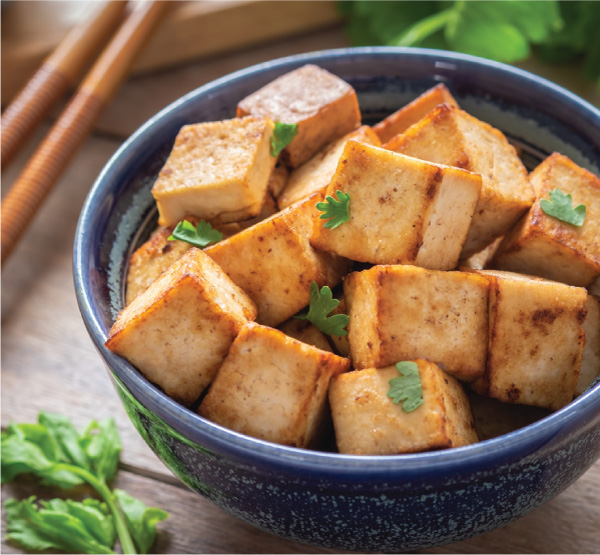
Endocrine Effects
The classification of isoflavones as phytoestrogens has led to considerable investigation on the effect of soyfoods on hormone levels in both men and women, especially the reproductive hormones. In regards to men, two case reports each describing a single individual that experienced a decrease in testosterone and/or an increase in estrogen levels, are typically cited as evidence of effects on hormone levels.21,22 However, both men reportedly ingested in the context of a nutrient deficient diet, about 360 mg/d isoflavones, an intake that is about nine-fold higher than is typical for Japanese men consuming a traditional diet.
In contrast to these case reports, a meta-analysis that included 32 clinical studies and 36 treatment groups found there were no significant effects of soy protein or isoflavone intake on levels of total testosterone, sex hormone binding globulin, free testosterone or the free androgen index.23 Studies published subsequent to this analysis are supportive of this conclusion.24-28 In addition, a narrative review that included nine clinical studies found no effect of soy on estrogen levels.29Research published subsequent to this review is supportive of this conclusion.28,30 Importantly, even when isoflavone exposure exceeded typical Japanese levels, clinical studies show hormone levels were unaffected.
As is the case for men, the clinical data indicate soy does not affect estrogen levels in women. Hooper et al.31 meta-analyzed the data from 47 clinical trials and found no effect of soy or isoflavone intervention on estradiol and other reproductive hormones in pre- and postmenopausal women.

Feritility
It is somewhat ironic that concerns about soy intake and fertility have been raised in traditionally high-soy-consuming Asian countries, given their large populations. In women, soyfoods appear to increase the length of the menstrual cycle by about one day.31 However, ovulation is not prevented but is simply delayed. Furthermore, there is some evidence that isoflavones aid female fertility. For example, a prospective study found that among 315 women who collectively underwent 520 assisted reproductive technology cycles, soy isoflavone intake was positively related to live birth rates.32
In addition, soy consumption appears to negate the adverse reproductive effects of the endocrine disruptor bisphenol A (BPA) on fertility. In a study involving 239 women undergoing in vitro fertilization, among those who did not consume soyfoods, urinary BPA levels were inversely related to live birth rates per initiated cycle – whereas no such relationship existed among soy-consumers.33 Although the low isoflavone intake among the soy consumers (mean intake, 3.4 mg/d) would normally raise doubt about the plausibility of these findings, they do agree with animal data.34,35
In men, a small pilot cross-sectional study found that very modest soy consumption was associated with lower sperm concentration – sperm count was not decreased – but there were many weaknesses to this study.36 In fact, much of the decreased sperm concentration occurred because there was an increase in ejaculate volume in men consuming higher amounts of soy, a finding which seems biologically implausible. Furthermore, this same research group subsequently conducted a cross-sectional study involving 184 men from couples undergoing infertility treatment with in vitro fertilization. They found that the male partner’s intake of soyfoods and soy isoflavones was unrelated to fertilization rates, proportions of poor quality embryos, accelerated or slow embryo cleavage rate, implantation, clinical pregnancy, and live birth among couples attending an infertility clinic.37
Finally, all three of the clinical studies conducted show that isoflavones have no effect on sperm concentration or quality.38-40 In one, healthy volunteers took a daily supplement containing 40 mg isoflavones for two months.38 In another, 32 healthy young men consumed diets in random order for 57 days that were supplemented with milk protein isolate or isolated soy protein containing a high or low amount of isoflavones.40 In the third study, 20 volunteers were randomized to three different groups in which they were provided 60, 320 or 480 mg/d isoflavones for three months.39 Interestingly, a case report indicated that daily isoflavone supplementation for six months in the male partner of an infertile couple with initially low sperm count led to normalization of sperm quality and quantity and allowed the couple to conceive.41
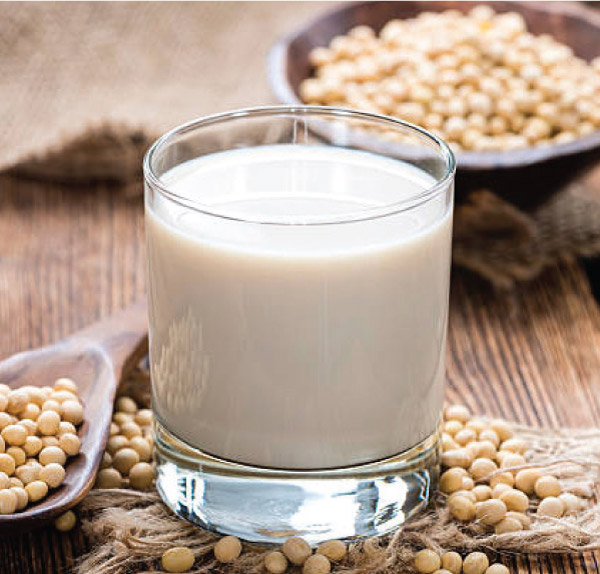
Soy, Isoflavonesand Thyroid Function
Concerns about soy’s effects on the thyroid are based primarily on in vitro research42,43 and studies in rodents administered isolated isoflavones.44,45 However, a comprehensive review published in 2006 that included 14 clinical trials found that the totality of the evidence showed that neither soyfoods nor isoflavones adversely affect thyroid function in healthy men or women.46 Studies published subsequent to this review support this conclusion.47-51 As previously noted, in 2015, the European Food Safety Authority concluded that isoflavone exposure doesn’t affect thyroid function.7 Studies published subsequent to this report support this conclusion.52,53
There is also concern that soy may worsen thyroid function in those whose thyroid function is compromised, such as subclinical hypothyroid patients and those whose iodine intake is marginal. The latter concern is based on the potential for isoflavones rather than the amino acid tyrosine to be iodinated, thereby inhibiting the synthesis of thyroid hormone.54 However, clinical research published in 2012 showed that the iodination of isoflavones is negligible and clinically irrelevant.55 One small British study did find that modest isoflavone exposure (16 mg/d) increased the likelihood of progressing from subclinical to overt hypothyroidism.56 However, it would be premature to base clinical decisions on the findings from this one study. Furthermore, this study also found that in all participants, isoflavone exposure caused marked and statistically significant reductions in systolic and diastolic blood pressure, insulin resistance and inflammation (as assessed by C-reactive protein).56
Although soy has no effect on thyroid function in euthyroid individuals, soyfoods may increase the amount of thyroid medication needed by hypothyroid patients. This is not because of an effect on the thyroid, but because soy protein may interfere to some extent with the absorption of the medication.57-60 However, soy is not unique in this regard, as many herbs, drugs, fiber, and calcium supplements have similar effects.61-69 In any event, it is not necessary for thyroid patients (with the exception of infants with congenital hypothyroidism) to avoid soyfoods, since thyroid medication is taken on an empty stomach. Typically, it is recommended to wait one to three hours after taking thyroid hormone before consuming anything that might interfere with its absorption.
| Soyfood | Serving Size | Total (MG) Isoflavone/Serving |
|---|---|---|
| Miso | 1 tbsp | 7 |
| Soybeans, Green, Cooked | ½ cup | 50 |
| Soybeans, Black, Cooked | ½ cup | 40 |
| Soybeans, Yellow, Cooked | ½ cup | 78 |
| Soybeans, Roasted, Plain | ¼ cup | 78 |
| Soymilk, Plain, Unfortified | 1 cup | 10 |
| Soymilk, Plain, Fortified | 1 cup | 43 |
| Soy Flour, Defatted | ¼ cup | 42 |
| Soy Flour, Full-Fat | ¼ cup | 33 |
| Soy Flour, Low-Fat | ¼ cup | 33 |
| Soy Crumbles | ½ cup | 9 |
| Soy Protein Isolate Powder, Plain | ⅓ cup | 53 |
| Textured Soy Protein, Dry | ¼ cup | 53 |
| Tempeh | ½ cup | 53 |
| Tofu | ½ cup | 25 |
Source: United States Department of Agriculture Nutrient Database.
An alternative approach to temporal separation between thyroid hormone ingestion and the consumption of soy is to maintain consistency in medication administration and dietary habits so that the dose of medication can be adjusted, if necessary. As long as the medication is taken in a consistent manner and the amount of soyfoods consumed is relatively constant, soy should not be an issue.70
Fast Facts
About Isoflavones
| 1 | Isoflavones are one of five chemical classes of anticarcinogens found in soy |
| 2 | Soyfoods are the only significant natural dietary source of isoflavones |
| 3 | Research shows isoflavones may prevent the onset of osteoporosis and may protect against various forms of cancer |

Breast Cancer Patients
Despite the proposed breast cancer-preventive effects,71 there has been concern that because soyfoods contain isoflavones, they worsen the prognosis of women with breast cancer and increase the risk of developing breast cancer in women who are at high risk for this disease.72 It is worth noting that although estrogen does stimulate the growth of some breast tumors, the evidence that estrogen therapy increases breast cancer risk is very unclear. In fact, in the Women’s Health Initiative trials, estrogen therapy led to a statistically significant decreased risk of dying from breast cancer, whereas estrogen plus progestin therapy led to a significant increase.73
No intervention study has examined the impact of soy consumption on breast cancer recurrence and/or mortality. However, the impact of soy on several established markers of breast cancer risk, including mammographic density74,75 and breast cell proliferation,76 has been studied extensively. The results of this research are extremely reassuring, and they show that even when isoflavone exposure greatly exceeds typical Japanese intake (~40 mg/d), 10 breast tissue is not adversely affected.77-84 Not surprisingly, this was the conclusion reached by the European Food Safety Authority in 2015 after a multi-year comprehensive evaluation of the literature.85
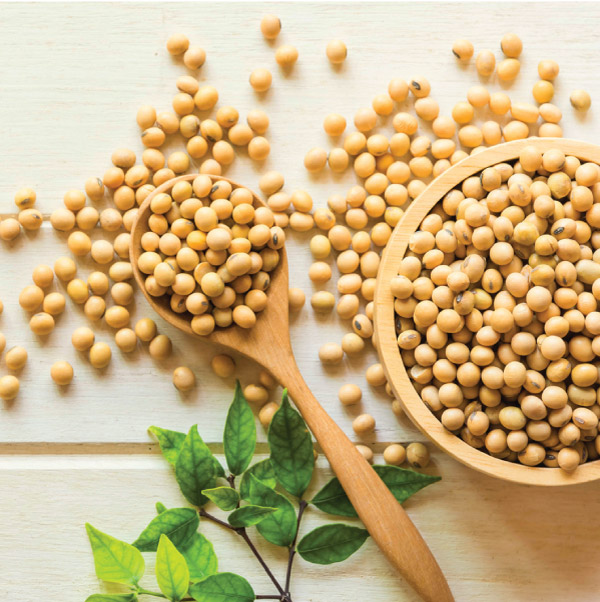

In 2018, a report from the AICR and the World Cancer Research Fund concluded that post-diagnosis soy intake may improve the survival of breast cancer patients.9 The positions of these cancer organizations are not surprising, given the results of meta-analysis (N=11,206) by Chi et al.86 that included three prospective studies from China87-89 and two from the U.S.,90,91 that involved more than 11,000 women with breast cancer.
In this analysis, when comparing extremes of post-diagnosis soyfood intake, higher intake was associated with reduced mortality (hazard ratio, 0.84; 95 percent confidence interval: 0.71, 0.99). When comparing extremes of post-diagnosis isoflavone intake, intake was associated with a decrease in recurrence (hazard ratio, 0.74; 95 percent confidence interval: 0.64, 0.85).86 The benefits of post-diagnosis soy intake were evident in both estrogen receptor-negative and estrogen receptor-positive breast cancer patients and was equally beneficial in Chinese and U.S. women.92 Interestingly, in contrast to studies in mice, the epidemiologic data suggest that soy consumption may actually enhance the efficacy of chemotherapeutic agents used to treat breast cancer.87,92
Mineral Status
Soyfoods are frequently used in place of animal foods. Many animal foods are good sources of iron and zinc and in the case of dairy foods’, calcium. Relatively little red meat is needed to meet daily iron and zinc requirements. As a result, questions about the effects of soy on the status of these two minerals pertains mostly to those eating a predominately plant-based diet.93
Like other legumes and whole grains, soybeans are high in phytate,94 which acute studies show reduces the absorption of zinc and iron.95 In the U.S., the Food and Nutrition Board (FNB) recommends a zinc intake for vegetarians whose diet contains generous amounts of grains and legumes that is 50 percent higher than the recommended dietary allowance (RDA) for non-vegetarians; although, the FNB has not formally established a vegetarian RDA.96
Zinc absorption from soyfoods is only modestly lower than that from animal sources. However, because soybeans contain relatively little zinc, unfortified soyfoods are not particularly good sources of this mineral.97-100 Zinc status is difficult to assess.101,102 Consequently, those consuming a plant-based diet are advised to specifically identify good plant sources of zinc in their diet and/or to take a zinc supplement.103-107
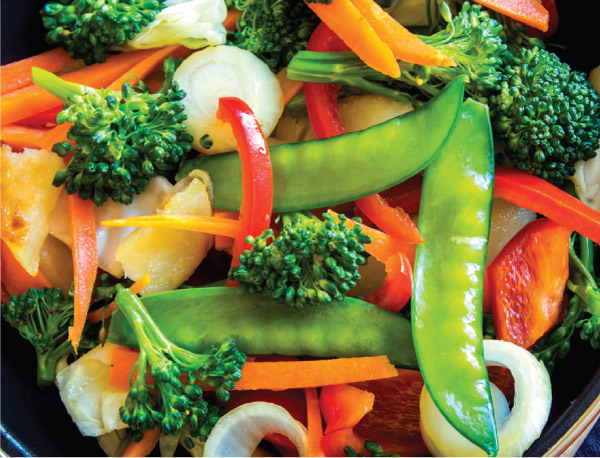
In contrast to zinc, soyfoods are relatively high in iron.108 Until recently, it was believed that the iron was poorly absorbed from all plant foods, including soyfoods. For this reason, the vegetarian iron RDA is 80 percent higher than that for non-vegetarians. This higher RDA derives from the assumption that the bioavailability of iron from a vegetarian diet is about 10 percent whereas that from a non-vegetarian diet is 18 percent.109
However, relatively new research utilizing improved methodology indicates that iron absorption from soy may be much higher than previously thought because most of the iron in soy is in the form of ferritin. Although there is debate about the bioavailability of ferritin iron, clinical studies in which participants were fed either soyfoods or soybean ferritin show it to be highly bioavailable.51,110,111
Finally, a study published in 2015 shows that in contrast to older understanding,112 there appears to be adaptation to the inhibitory effects of phytate on iron absorption.113 For this study, 32 nonanemic premenopausal women with suboptimal iron stores were randomly assigned to a high or low-phytate diet for eight weeks. The serum iron response over four hours after a test meal containing 350 mg of phytate was measured at baseline and post intervention.
The serum iron response to the test meal increased in the high-phytate group at post intervention, resulting in a 41 percent increase in the area under the curve. However, no effect was observed in the low-phytate group. It is reasonable to speculate that chronically consuming a high-phytate diet will lead to a mitigation of the inhibitory effects of phytate on the absorption of not just iron, but possibly other minerals as well.
In addition to phytate, soybeans are also high in oxalate, another compound that binds calcium and reduces its absorption.114 Oxalate is one reason that even though spinach is high in calcium, it is not a good source of this mineral. Calcium absorption from soybeans is surprisingly good – despite the presence of both phytate and oxalate.115 This is also true for calcium-set tofu116 and calcium-fortified soymilk.117-119 In fact, the absorption of calcium from these foods is comparable to the absorption of calcium from cow’s milk.

Allergies
Soy protein can cause allergic reactions in sensitive individuals, as is the case for essentially all food proteins. Soy protein is one of the eight foods that compromise the Big 8 and are responsible for approximately 90 percent of all food-induced allergic reactions in the U.S.120 However, these foods are not equally allergenic and allergy to soy protein is relatively uncommon.121 Furthermore, it is important to recognize that the Big 8 could have easily been a list of a different size as there is no scientific basis for this group being comprised of eight foods.In Europe, it is the Big 14122 and in Japan it is the Big 7.123
If the U.S. list included only seven foods, it is likely soy would not be on the list. In support of this statement are the results of the Food Safety Survey, which is conducted by the FDA approximately every five years. Data for the most recent survey (2010), which involved nearly 5,000 participants, show that approximately only one out of 1,000 adults (0.1 percent) self-report a doctor-diagnosed allergy to soy protein.124 In comparison, the prevalence of allergy to the other seven foods in the Big 8 is much higher: milk/dairy (2%), shellfish (1.6%), wheat and/or gluten (0.9%), fish (0.8%), tree nuts (0.7%), peanuts (0.6%) and eggs (0.5%). Furthermore, this survey found the prevalence of allergy to pea protein and chocolate was each 0.1%, the same as soy protein even though neither of these foods is included in the Big 8.
In general, the prevalence of food allergy among children is greater than among adults. However, similar to adults, the prevalence of soy allergy among children is relatively low compared to many other foods.125 For example, in a survey involving nearly 40,000 individuals below the age of 18, the prevalence of allergic reactions to peanuts and milk was five and four times more common, respectively, than the prevalence of allergic reactions to soy protein.125
Data from Europe helps to emphasize that soy protein allergy is quite uncommon. Although soy is one of the Big 14, a recently published study involving six European countries found that the prevalence of allergy to 19 foods was greater than the prevalence of allergy to soy protein.126 In agreement, a survey of nearly 5,000 adults in Western Europe found that of 24 foods evaluated, allergic reactions to 18 of these foods were more common than reactions to soy protein.127

It is particularly informative to note that according to a report from Europrevall, “... data indicate that some allergens for which labelling is mandated and for which management measures are therefore instituted (e.g. soy, mustard), appear to have a lower public health impact than some, which are not required to be declared (e.g. some fruits).”128 EuroPrevall is a multidisciplinary project, including 62 institutions from 22 European countries. The organization is charged with studying the prevalence and distribution of food allergies in infants, children, adolescents, and adults in Europe.
Soy Infant Formula
Soy infant formula (SIF) has been in use for more than 50 years. During this time, an estimated 20 million Americans used SIF during infancy. Current data from a nationally representative sample of 1,864 infants, zero to 12 months old, from the National Health and Nutrition Examination Survey, 2003-2010, show that among the 81% of infants who were fed formula or regular milk, 12.9% consumed SIF.130
SIF produces normal growth and development; nevertheless, SIF use has become controversial because of its high isoflavone content. In 2009, the U.S. National Toxicology Program (NTP) concluded there was minimal concern about the safety of SIF.131 In response to this conclusion, the American Academy of Pediatrics submitted a letter to the NTP, which is now part of the public record,stating that, there was negligible concern about the safety of SIF. The five levels of concern at thetime this letter was submitted were negligible,minimal, some, concern, and serious concern.studies. It is notable that a small Israeli study found SIF use wasn’t associated with puberty onset in boys or girls.140
Considerable insight to the health effects of SIF will be gained over the next few years as a result of research underway at the Arkansas Children’s Nutrition Center, University of Arkansas for Medical Sciences. At this center,they are comparing the health status of infants fed breast milk, cow’s milk formula and SIF. Thus far, findings indicate that all health parameters assessed in infants fed SIF are well within the normal range.132-136
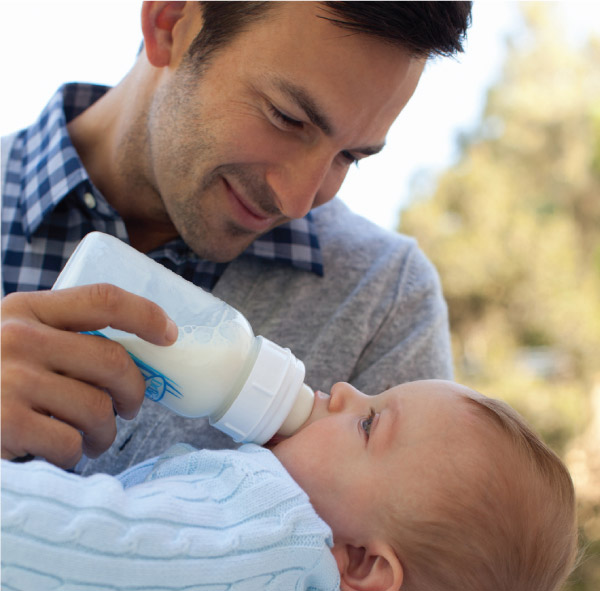
The first systematic review and meta-analysis focused on the safety of SIF concluded that SIF intake in normal full-term infants – even during the most rapid phase of growth – is associated with normal anthropometric growth, adequate protein status, bone mineralization and normal immune development.137 However, the resultsof a very recently published epidemiologic study suggest that SIF may exert modest estrogenic effects in infant girls (not boys). Although,whether these observed effects are transient and whether they have any long-term clinical implications wasn’t able to be determined.138 It is noteworthy in this regard that a very recent study found there were no long-term effects resulting from marked differences in growth patterns up to four months of age due to differences in formula feeding, on anthropometry
It is noteworthy in this regard that a very recent study found there were no long-term effects resulting from marked differences in growth patterns up to four months of age due to differences in formula feeding, on anthropometry at four years of age.139 This study should give considerable pause about drawing conclusions about the long-term health implications of formula feeding based on differences observed in infants. Insights about infant feeding patterns may need to come from long-term prospective studies or carefully controlled retrospective studies. It is notable that a small Israeli study found SIF use wasn’t associated with puberty onset in boys or girls.140
Soyfood Processing
Tofu and miso are commonly consumed soyfoods in Asia whereas in the U.S., many people choose more refined forms of soy such as meat analogs and energy bars – which use as a base concentrated forms of soy protein.10 Numerous human studies demonstrate that these modern soy products provide very high-quality protein.141,142
Depending on processing methods, the isoflavone content of these foods can be markedly reduced.143 The isoflavone content of a large number of soy-containing foods can be found in an online database created by Iowa State University and the United States Department of Agriculture. Hexane is often used in the defatting of soybeans but only very trace amounts of this alkane can be found in the meal or oil.144,145
Many traditional soyfoods such as miso, tempeh, and natto undergo fermentation. Fermentation reduces the content of several compounds traditionally classified as anti-nutrients including phytate146 and protease inhibitor,147 and may even reduce antigenicity.148 However, any benefits of these fermentation-induced changes have yet to be demonstrated clinically. To the contrary, several epidemiologic studies show protective effects against different cancers associated with the intake of only unfermented soyfoods.149,150 Unfermented soyfoods have been consumed in Japan151 and China152 for at least 500 and 1,000 years, respectively. Even in Japan, where fermented soyfoods such as miso and natto are very popular, about half of the total soy consumed comes from foods that are not fermented (primarily tofu).17,18 Among ethnic Chinese – including people from China, Singapore and Hong Kong – nearly all of the soy consumed is unfermented.19

Summary and Conclusions
When evaluating the safety of soyfoods, it is imperative to consider the totality of the scientific research and place appropriate weight on studies according to their experimental design. The research overall indicates that soyfoods can be safely incorporated into the diets of essentially all healthy individuals with the exception of those allergic to soy protein, which is relatively uncommon. Nevertheless, because all foods have the potential to cause undesirable effects in some individuals, people with specific health concerns should consult their healthcare provider regarding unique nutritional needs.
References
1. Food Labeling: Health Claims; Soy Protein and Coronary Heart Disease. In: Federal Register: (Volume 64, Number 206)]; 1999:57699-733.
2. Balk E, Chung M, Chew P, et al. Effects of soy on health outcomes. Evidence report/technology assessment No. 126 (prepared by Tufts-New England Medical Center Evidence-based Practice Center under Contract No. 290-02-0022.) AHRQ Publication No. 05-E024-2. Rockville, MD Agency for Healthcare Research and Quality; July 2005.
3. Tempfer CB, Froese G, Heinze G, et al. Side effects of phytoestrogens: a meta-analysis of randomized trials. Am J Med. 2009;122(10):939-46 e9.
4. Rock CL, Doyle C, Demark-Wahnefried W, et al. Nutrition and physical activity guidelines for cancer survivors. CA Cancer J Clin. 2012;62(4):242-74.
5. American Institute for Cancer Research. Soy is safe for breast cancer survivors. http://wwwaicrorg/cancer-research-update/november_21_2012/cru-soy-safehtml(accessed Feburary 5, 2013). 2012.
6. Benkhedda K, Boudrault C, Sinclair SE, et al. Food Risk Analysis Communication. Issued By Health Canada’s Food Directorate. Health Canada’s Proposal to Accept a Health Claim about Soy Products and Cholesterol Lowering. Int Food Risk Anal J. 2014;4:22 | doi: 10.5772/59411.
7. EFSA ANS Panel (EFSA Panel on Food Additives and Nutrient Sources added to Food), 2015. Scientific opinion on the risk assessment for peri- and post-menopausal women taking food supplements containing isolated isoflavones. EFSA J. 2015;13(10):4246 (342 pp).
8. US Food and Drug Administration. Food labeling: health claims; Soy protein and coronary heart disease. Fed Reg. 2017;8250324-46.
9. American Institute for Cancer Research, World Cancer Research Fund. Diet, nutrition, physical activity and breast cancer survivors. Updated 2018. Continuous update project (http://www.aicr.org/continuous-update-project/breast-cancer.html). Accessed July 14, 2018.
10. Messina M, Nagata C, Wu AH. Estimated Asian adult soy protein and isoflavone intakes. Nutr Cancer. 2006;55(1):1-12.
11. Nakamoto M, Otsuka R, Nishita Y, et al. Soy food and isoflavone intake reduces the risk of cognitive impairment in elderly Japanese women. Eur J Clin Nutr. 2018.
12. Liu Z, Li W, Sun J, et al. Intake of soy foods and soy isoflavones by rural adult women in China. Asia Pacific journal of clinical nutrition. 2004;13(2):204-9.
13. Lee SA, Wen W, Xiang YB, et al. Assessment of dietary isoflavone intake among middle-aged Chinese men. J Nutr. 2007;137(4):1011-6.
14. Villegas R, Yang G, Liu D, et al. Validity and reproducibility of the food-frequency questionnaire used in the Shanghai men’s health study. Br J Nutr. 2007;97(5):993-1000.
15. Yang G, Shu XO, Jin F, et al. Longitudinal study of soy food intake and blood pressure among middle-aged and elderly Chinese women. Am J Clin Nutr. 2005;81(5):1012-7.
16. Kim YJ, Park MY, Chang N, et al. Intake and major sources of dietary flavonoid in Korean adults: Korean National Health and Nutrition Examination Survey 2010-2012. Asia Pacific journal of clinical nutrition. 2015;24(3):456-63.
17. Wakai K, Egami I, Kato K, et al. Dietary intake and sources of isoflavones among Japanese. Nutr Cancer. 1999;33(2):139-45.
18. Somekawa Y, Chiguchi M, Ishibashi T, et al. Soy intake related to menopausal symptoms, serum lipids, and bone mineral density in postmenopausal Japanese women. Obstet Gynecol. 2001;97(1):109-15.
19. Zhang X, Shu XO, Gao YT, et al. Soy food consumption is associated with lower risk of coronary heart disease in Chinese women. J Nutr. 2003;133(9):2874-8.
20. Lee MJ, Kim JH. Estimated dietary isoflavone intake among Korean adults. Nutrition research and practice. 2007;1(3):206-11.
21. Martinez J, Lewi JE. An unusual case of gynecomastia associated with soy product consumption. Endocr Pract. 2008;14(4):415-8.
22. Siepmann T, Roofeh J, Kiefer FW, et al. Hypogonadism and erectile dysfunction associated with soy product consumption. Nutrition. 2011;27(7-8):859-62.
23. Hamilton-Reeves JM, Vazquez G, Duval SJ, et al. Clinical studies show no effects of soy protein or isoflavones on reproductive hormones in men: results of a meta-analysis. Fertil Steril. 2010;94(3):997-1007.
24. Deibert P, Solleder F, Konig D, et al. Soy protein based supplementation supports metabolic effects of resistance training in previously untrained middle aged males. Aging Male. 2011;14(4):273-9.
25. Miyanaga N, Akaza H, Hinotsu S, et al. Prostate cancer chemoprevention study: an investigative randomized control study using purified isoflavones in men with rising prostate-specific antigen. Cancer Sci. 2012;103(1):125-30.
26. Sathyapalan T, Rigby AS, Bhasin S, et al. Effect of soy in men with type 2 diabetes mellitus and subclinical hypogonadism: A randomized controlled study. J Clin Endocrinol Metab. 2017;102(2):425-33.
27. Hamilton-Reeves JM, Banerjee S, Banerjee SK, et al. Short-term soy isoflavone intervention in patients with localized prostate cancer: a randomized, double-blind, placebo-controlled trial. PloS one. 2013;8(7):e68331.
28. Haun CT, Mobley CB, Vann CG, et al. Soy protein supplementation is not androgenic or estrogenic in college-aged men when combined with resistance exercise training. Scientific reports. 2018;8(1):11151.
29. Messina M. Soybean isoflavone exposure does not have feminizing effects on men: a critical examination of the clinical evidence. Fertil Steril. 2010;93(7):2095-104.
30. Kumar NB, Kang L, Pow-Sang J, et al. Results of a randomized phase I dose-finding trial of several doses of isoflavones in men with localized prostate cancer: administration prior to radical prostatectomy. J Soc Integr Oncol. 2010;8(1):3-13.
31. Hooper L, Ryder JJ, Kurzer MS, et al. Effects of soy protein and isoflavones on circulating hormone concentrations in pre- and post-menopausal women: a systematic review and meta-analysis. Hum Reprod Update. 2009;15(4):423-40.
32. Vanegas JC, Afeiche MC, Gaskins AJ, et al. Soy food intake and treatment outcomes of women undergoing assisted reproductive technology. Fertil Steril. 2015;103(3):749-55 e2.
33. Chavarro JE, Minguez-Alarcon L, Chiu YH, et al. Soy intake modifies the relation between urinary bisphenol A concentrations and pregnancy outcomes among women undergoing assisted reproduction. J Clin Endocrinol Metab. 2016jc20153473.
34. Muhlhauser A, Susiarjo M, Rubio C, et al. Bisphenol A effects on the growing mouse oocyte are influenced by diet. Biol Reprod. 2009;80(5):1066-71.
35. Dolinoy DC, Huang D, Jirtle RL. Maternal nutrient supplementation counteracts bisphenol A-induced DNA hypomethylation in early development. Proc Natl Acad Sci U S A. 2007;104(32):13056-61.
36. Chavarro JE, Toth TL, Sadio SM, et al. Soy food and isoflavone intake in relation to semen quality parameters among men from an infertility clinic. Hum Reprod. 2008;23(11):2584-90.
37. Minguez-Alarcon L, Afeiche MC, Chiu YH, et al. Male soy food intake was not associated with in vitro fertilization outcomes among couples attending a fertility center. Andrology. 2015;3(4):702-8.
38. Mitchell JH, Cawood E, Kinniburgh D, et al. Effect of a phytoestrogen food supplement on reproductive health in normal males. Clin Sci (Lond). 2001;100(6):613-8.
39. Messina M, Watanabe S, Setchell KD. Report on the 8th International Symposium on the Role of Soy in Health Promotion and Chronic Disease Prevention and Treatment. J Nutr. 2009;139(4):796S-802S.
40. Beaton LK, McVeigh BL, Dillingham BL, et al. Soy protein isolates of varying isoflavone content do not adversely affect semen quality in healthy young men. Fertil Steril. 2010;94(5):1717-22.
41. Casini ML, Gerli S, Unfer V. An infertile couple suffering from oligospermia by partial sperm maturation arrest: can phytoestrogens play a therapeutic role? A case report study. Gynecol Endocrinol. 2006;22(7):399-401.
42. Divi RL, Doerge DR. Inhibition of thyroid peroxidase by dietary flavonoids. Chem Res Toxicol. 1996;9(1):16-23.
43. Divi RL, Chang HC, Doerge DR. Anti-thyroid isoflavones from soybean: isolation, characterization, and mechanisms of action. Biochem Pharmacol. 1997;54(10):1087-96.
44. Chang HC, Doerge DR. Dietary genistein inactivates rat thyroid peroxidase in vivo without an apparent hypothyroid effect. Toxicol Appl Pharmacol. 2000;168(3):244-52.
45. Chang HC, Churchwell MI, Delclos KB, et al. Mass spectrometric determination of genistein tissue distribution in diet-exposed Sprague-Dawley rats. J Nutr. 2000;130(8):1963-70.
46. Messina M, Redmond G. Effects of soy protein and soybean isoflavones on thyroid function in healthy adults and hypothyroid patients: a review of the relevant literature. Thyroid. 2006;16(3):249-58.
47. Ryan-Borchers T, Boon C, Park JS, et al. Effects of dietary and supplemental forms of isoflavones on thyroid function in healthy postmenopausal women. Topics Clinical Nutr. 2008;2313-22.
48. Romualdi D, Costantini B, Campagna G, et al. Is there a role for soy isoflavones in the therapeutic approach to polycystic ovary syndrome? Results from a pilot study. Fertil Steril. 2008;90(5):1826-33.
49. Nahas EA, Nahas-Neto J, Orsatti FL, et al. Efficacy and safety of a soy isoflavone extract in postmenopausal women: a randomized, double-blind, and placebo-controlled study. Maturitas. 2007;58(3):249-58.
50. Khaodhiar L, Ricciotti HA, Li L, et al. Daidzein-rich isoflavone aglycones are potentially effective in reducing hot flashes in menopausal women. Menopause. 2008;15(1):125-32.
51. Zhou Y, Alekel DL, Dixon PM, et al. The effect of soy food intake on mineral status in premenopausal women. J Womens Health (Larchmt). 2011;20(5):771-80.
52. Sathyapalan T, Javed Z, Rigby AS, et al. Soy protein improves cardiovascular risk in subclinical hypothyroidism: A randomized double-blinded crossover study. Journal of the Endocrine Society. 2017;1(5):423-30.
53. Sathyapalan T, Aye M, Rigby AS, et al. Soy reduces bone turnover markers in women during early menopause: A randomized controlled trial. J Bone Miner Res. 2017;32(1):157-64.
54. Doerge D, Chang H. Inactivation of thyroid peroxidase by soy isoflavones, in vitro and in vivo. Journal of chromatography B, Analytical technologies in the biomedical and life sciences. 2002;777(1-2):269-79.
55. Sosvorova L, Miksatkova P, Bicikova M, et al. The presence of monoiodinated derivates of daidzein and genistein in human urine and its effect on thyroid gland function. Food Chem Toxicol. 2012;50(8):2774-9.
56. Sathyapalan T, Manuchehri AM, Thatcher NJ, et al. The effect of soy phytoestrogen supplementation on thyroid status and cardiovascular risk markers in patients with subclinical hypothyroidism: a randomized, double-blind, crossover study. J Clin Endocrinol Metab. 2011;96(5):1442-9.
57. Doerge DR, Sheehan DM. Goitrogenic and estrogenic activity of soy isoflavones. Environ Health Perspect. 2002;110 Suppl 3349-53.
58. Fitzpatrick M. Soy formulas and the effects of isoflavones on the thyroid. N Z Med J. 2000;113(1103):24-6.
59. Bell DS, Ovalle F. Use of soy protein supplement and resultant need for increased dose of levothyroxine. Endocr Pract. 2001;7(3):193-4.
60. Conrad SC, Chiu H, Silverman BL. Soy formula complicates management of congenital hypothyroidism. Arch Dis Child. 2004;89(1):37-40.
61. Liel Y, Harman-Boehm I, Shany S. Evidence for a clinically important adverse effect of fiber-enriched diet on the bioavailability of levothyroxine in adult hypothyroid patients. J Clin Endocrinol Metab. 1996;81(2):857-9.
62. Chiu AC, Sherman SI. Effects of pharmacological fiber supplements on levothyroxine absorption. Thyroid. 1998;8(8):667-71.
63. Shakir KM, Chute JP, Aprill BS, et al. Ferrous sulfate-induced increase in requirement for thyroxine in a patient with primary hypothyroidism. South Med J. 1997;90(6):637-9.
64. Liel Y, Sperber AD, Shany S. Nonspecific intestinal adsorption of levothyroxine by aluminum hydroxide. Am J Med. 1994;97(4):363-5.
65. Sperber AD, Liel Y. Evidence for interference with the intestinal absorption of levothyroxine sodium by aluminum hydroxide. Arch Intern Med. 1992;152(1):183-4.
66. Sherman SI, Tielens ET, Ladenson PW. Sucralfate causes malabsorption of L-thyroxine. Am J Med. 1994;96(6):531-5.
67. Siraj ES, Gupta MK, Reddy SS. Raloxifene causing malabsorption of levothyroxine. Arch Intern Med. 2003;163(11):1367-70.
68. Rosenberg R. Malabsorption of thyroid hormone with cholestyramine administration. Conn Med. 1994;58(2):109.
69. Harmon SM, Seifert CF. Levothyroxine-cholestyramine interaction reemphasized. Ann Intern Med. 1991;115(8):658-9.
70. Zeitler P, Solberg P. Food and levothyroxine administration in infants and children. J Pediatr. 2010;157(1):13-4.
71. Xie Q, Chen ML, Qin Y, et al. Isoflavone consumption and risk of breast cancer: a dose-response meta-analysis of observational studies. Asia Pacific journal of clinical nutrition. 2013;22(1):118-27.
72. Helferich WG, Andrade JE, Hoagland MS. Phytoestrogens and breast cancer: a complex story. Inflammopharmacology. 2008;16(5):219-26.
73. Manson JE, Aragaki AK, Rossouw JE, et al. Menopausal hormone therapy and long-term all-cause and cause-specific mortality: The Women’s Health Initiative randomized trials. JAMA. 2017;318(10):927-38.
74. Boyd NF, Martin LJ, Yaffe MJ, et al. Mammographic density and breast cancer risk: current understanding and future prospects. Breast cancer research : BCR. 2011;13(6):223.
75. Rice MS, Bertrand KA, VanderWeele TJ, et al. Mammographic density and breast cancer risk: a mediation analysis. Breast cancer research : BCR. 2016;18(1):94.
76. Huh SJ, Oh H, Peterson MA, et al. The proliferative activity of mammary epithelial cells in normal tissue predicts breast cancer risk in premenopausal women. Cancer Res. 2016;76(7):1926-34.
77. Hooper L, Madhavan G, Tice JA, et al. Effects of isoflavones on breast density in pre- and post-menopausal women: a systematic review and meta-analysis of randomized controlled trials. Hum Reprod Update. 2010;16(6):745-60.
78. Wu AH, Spicer D, Garcia A, et al. Double-blind randomized 12-month soy intervention had no effects on breast MRI fibroglandular tissue density or mammographic density. Cancer Prev Res (Phila). 2015;8(10):942-51.
79. Hargreaves DF, Potten CS, Harding C, et al. Two-week dietary soy supplementation has an estrogenic effect on normal premenopausal breast. J Clin Endocrinol Metab. 1999;84(11):4017-24.
80. Sartippour MR, Rao JY, Apple S, et al. A pilot clinical study of short-term isoflavone supplements in breast cancer patients. Nutr Cancer. 2004;49(1):59-65.
81. Palomares MR, Hopper L, Goldstein L, et al. Effect of soy isoflavones on breast proliferation in postmenopausal breast cancer survivors. Breast Cancer Res Treatment. 2004;88 (Suppl 1)4002 (Abstract).
82. Cheng G, Wilczek B, Warner M, et al. Isoflavone treatment for acute menopausal symptoms. Menopause. 2007;14(3 Pt 1):468-73.
83. Khan SA, Chatterton RT, Michel N, et al. Soy isoflavone supplementation for breast cancer risk reduction: A randomized phase II trial. Cancer Prev Res (Phila). 2012;5(2):309-19.
84. Shike M, Doane AS, Russo L, et al. The effects of soy supplementation on gene expression in breast cancer: a randomized placebo-controlled study. J Natl Cancer Inst. 2014;106(9).
85. EFSA. EFSA ANS Panel (EFSA Panel on Food Additives and Nutrient Sources added to Food), 2015. Scientific opinion on the risk assessment for peri- and post-menopausal women taking food supplements containing isolated isoflavones. EFSA J. 13,4246 (342 pp). 2015.
86. Chi F, Wu R, Zeng YC, et al. Post-diagnosis soy food intake and breast cancer survival: A meta-analysis of cohort studies. Asian Pacific journal of cancer prevention : APJCP. 2013;14(4):2407-12.
87. Kang X, Zhang Q, Wang S, et al. Effect of soy isoflavones on breast cancer recurrence and death for patients receiving adjuvant endocrine therapy. CMAJ. 2010;182(17):1857-62.
88. Zhang YF, Kang HB, Li BL, et al. Positive effects of soy isoflavone food on survival of breast cancer patients in China. Asian Pacific journal of cancer prevention : APJCP. 2012;13(2):479-82.
89. Shu XO, Zheng Y, Cai H, et al. Soy food intake and breast cancer survival. JAMA. 2009;302(22):2437-43.
90. Guha N, Kwan ML, Quesenberry CP, Jr., et al. Soy isoflavones and risk of cancer recurrence in a cohort of breast cancer survivors: the Life After Cancer Epidemiology study. Breast Cancer Res Treat. 2009;118(2):395-405.
91. Caan BJ, Natarajan L, Parker B, et al. Soy food consumption and breast cancer prognosis. Cancer Epidemiol Biomarkers Prev. 2011;20(5):854-8.
92. Nechuta SJ, Caan BJ, Chen WY, et al. Soy food intake after diagnosis of breast cancer and survival: an in-depth analysis of combined evidence from cohort studies of US and Chinese women. Am J Clin Nutr. 2012;96(1):123-32.
93. Johnson JM, Walker PM. Zinc and iron utilization in young women consuming a beef-based diet. J Am Diet Assoc. 1992;92(12):1474-8.
94. Thompson DB, Erdman JWJ. Phytic acid determination in soybeans. J Food Sci. 1982;47513-7.
95. Urbano G, Lopez-Jurado M, Aranda P, et al. The role of phytic acid in legumes: antinutrient or beneficial function? J Physiol Biochem. 2000;56(3):283-94.
96. Institute of Medicine FaNB. Dietary Reference Intakes for Vitamin A, Vitamin K, Arsenic, Boron, Chromium, Copper, Iodine, Iron, Manganese, Molybdenum, Nickel, Silicon, Vanadium, and Zinc. Washington, DC: National Academy Press; 2001.
97. Sandstrom B, Cederblad A. Zinc absorption from composite meals. II. Influence of the main protein source. Am J Clin Nutr. 1980;33(8):1778-83.
98. Sandstrom B, Kivisto B, Cederblad A. Absorption of zinc from soy protein meals in humans. J Nutr. 1987;117(2):321-7.
99. Davidsson L, Almgren A, Sandstrom B, et al. Zinc absorption in adult humans: the effect of protein sources added to liquid test meals. Br J Nutr. 1996;75(4):607-13.
100. Lonnerdal B, Cederblad A, Davidsson L, et al. The effect of individual components of soy formula and cows’ milk formula on zinc bioavailability. Am J Clin Nutr. 1984;40(5):1064-70.
101. de Portela ML, Weisstaub AR. Basal urinary zinc/creatinine ratio as an indicator of dietary zinc intake in healthy adult women. J Am Coll Nutr. 2000;19(3):413-7.
102. Hunt JR. Moving toward a plant-based diet: are iron and zinc at risk? Nutr Rev. 2002;60(5 Pt 1):127-34.
103. Messina V, Melina V, Mangels AR. A new food guide for North American vegetarians. Can J Diet Pract Res. 2003;64(2):82-6.
104. Messina V, Melina V, Mangels AR. A new food guide for North American vegetarians. J Am Diet Assoc. 2003;103(6):771-5.
105. Mangels AR, Messina V. Considerations in planning vegan diets: infants. J Am Diet Assoc. 2001;101(6):670-7.
106. Messina V, Mangels AR. Considerations in planning vegan diets: children. J Am Diet Assoc. 2001;101(6):661-9.
107. Messina VK, Burke KI. Position of the American Dietetic Association: vegetarian diets. J Am Diet Assoc. 1997;97(11):1317-21.
108. Karr-Lilienthal LK, Grieshop CM, Merchen NR, et al. Chemical composition and protein quality comparisons of soybeans and soybean meals from five leading soybean-producing countries. J Agric Food Chem. 2004;52(20):6193-9.
109. Food and Nutrition Board, Institute of Medicine. Iron. In: Dietary References Intake for Vitamin A, Vitamin K, Arsenic, Boron, Chromium, Copper, Iodine, Iron, Manganese, Molybdenum, Nickel, Silicon,Vanadium and Zinc. Washington, DC: The National Academies Press; 2001:290-393.
110. Murray-Kolb LE, Welch R, Theil EC, et al. Women with low iron stores absorb iron from soybeans. Am J Clin Nutr. 2003;77(1):180-4.
111. Lonnerdal B, Bryant A, Liu X, et al. Iron absorption from soybean ferritin in nonanemic women. Am J Clin Nutr. 2006;83(1):103-7.
112. Brune M, Rossander L, Hallberg L. Iron absorption: no intestinal adaptation to a high-phytate diet. Am J Clin Nutr. 1989;49(3):542-5.
113. Armah SM, Boy E, Chen D, et al. Regular consumption of a high-phytate diet reduces the inhibitory effect of phytate on nonheme-iron absorption in women with suboptimal iron stores. J Nutr. 2015;145(8):1735-9.
114. Sandberg AS. Bioavailability of minerals in legumes. Br J Nutr. 2002;88 Suppl 3S281-5.
115. Heaney RP, Weaver CM, Fitzsimmons ML. Soybean phytate content: effect on calcium absorption. Am J Clin Nutr. 1991;53(3):745-7.
116. Weaver CM, Heaney RP, Connor L, et al. Bioavailability of calcium from tofu vs. milk in premenopausal women. J Food Sci. 2002;683144-7.
117. Zhao Y, Martin BR, Weaver CM. Calcium bioavailability of calcium carbonate fortified soymilk is equivalent to cow’s milk in young women. J Nutr. 2005;135(10):2379-82.
118. Tang AL, Walker KZ, Wilcox G, et al. Calcium absorption in Australian osteopenic post-menopausal women: an acute comparative study of fortified soymilk to cows’ milk. Asia Pacific journal of clinical nutrition. 2010;19(2):243-9.
119. Heaney RP, Dowell MS, Rafferty K, et al. Bioavailability of the calcium in fortified soy imitation milk, with some observations on method. Am J Clin Nutr. 2000;71(5):1166-9.
120. Food and Drug Administration (FDA). Food Allergen Labeling and Consumer Protection (FALCP) Act of 2004 hwcfgaap. http:// www.cfsan.fda.gov/~acrobat/alrgact.pdf.
121. Food and Drug Administration (FDA). Food Allergen Labeling and Consumer Protection (FALCP) Act of 2004. http://www.cfsan.fda.gov/~acrobat/alrgact.pdf,. 2004.
122. Asero R, Mistrello G, Amato S, et al. Unusual allergy to soy appeared in adult age. European annals of allergy and clinical immunology. 2016;48(3):94-6.
123. Shoji M, Adachi R, Akiyama H. Japanese Food Allergen Labeling Regulation: An Update. J AOAC Int. 2018;101(1):8-13.
124. Verrill L, Bruns R, Luccioli S. Prevalence of self-reported food allergy in U.S. adults: 2001, 2006, and 2010. Allergy Asthma Proc. 2015;36(6):458-67.
125. Gupta RS, Springston EE, Warrier MR, et al. The prevalence, severity, and distribution of childhood food allergy in the United States. Pediatrics. 2011;128(1):e9-17.
126. Bartra J, Garcia-Moral A, Enrique E. Geographical differences in food allergy. Bundesgesundheitsblatt, Gesundheitsforschung, Gesundheitsschutz. 2016;59(6):755-63.
127. Burney P, Summers C, Chinn S, et al. Prevalence and distribution of sensitization to foods in the European Community Respiratory Health Survey: a EuroPrevall analysis. Allergy. 2010;65(9):1182-8.
128. Project no. FOOD-CT-2005-514000 Project acronym: EUROPREVALL Project title: The Prevalence, Cost, and Basis of Food Allergy across Europe. Final Activity Report.
129. Vieths S, Reese G, Ballmer-Weber BK, et al. The serum bank of EuroPrevall - the prevalence, cost and basis of food allergy across Europe. Food Chem Toxicol. 2008;46 Suppl 10S12-4.
130. Rossen LM, Simon AE, Herrick KA. Types of infant formulas consumed in the United States. Clin Pediatr (Phila). 2015.
131. McCarver G, Bhatia J, Chambers C, et al. NTP-CERHR expert panel report on the developmental toxicity of soy infant formula. Birth Defects Res B Dev Reprod Toxicol. 2011;92(5):421-68.
132. Li J, Dykman RA, Jing H, et al. Cortical responses to speech sounds in 3- and 6-month-old infants fed breast milk, milk formula, or soy formula. Dev Neuropsychol. 2010;35(6):762-84.
133. Pivik RT, Andres A, Badger TM. Diet and gender influences on processing and discrimination of speech sounds in 3- and 6-month-old infants: a developmental ERP study. Dev Sci. 2011;14(4):700-12.
134. Gilchrist JM, Moore MB, Andres A, et al. Ultrasonographic patterns of reproductive organs in infants fed soy formula: comparisons to infants fed breast milk and milk formula. J Pediatr. 2010;156(2):215-20.
135. Pivik RT, Andres A, Tennal KB, et al. Infant diet, gender and the development of vagal tone stability during the first two years of life. Int J Psychophysiol. 2015;96(2):104-14.
136. Andres A, Cleves MA, Bellando JB, et al. Developmental status of 1-year-old infants fed breast milk, cow’s milk formula, or soy formula. Pediatrics. 2012;129(6):1134-40.
137. Vandenplas Y, Castrellon PG, Rivas R, et al. Safety of soya-based infant formulas in children. Br J Nutr. 2014;111(8):1340-60.
138. Adgent MA, Umbach DM, Zemel BS, et al. A longitudinal study of estrogen-responsive tissues and hormone concentrations in infants fed soy formula. J Clin Endocrinol Metab. 2018;103(5):1899-909.
139. Fleddermann M, Demmelmair H, Hellmuth C, et al. Association of infant formula composition and anthropometry at 4 years: Follow-up of a randomized controlled trial (BeMIM study). PloS one. 2018;13(7):e0199859.
140. Sinai T, Ben-Avraham S, Guelmann-Mizrahi I, et al. Consumption of soy-based infant formula is not associated with early onset of puberty. Eur J Nutr. 2018.
141. Rand WM, Pellett PL, Young VR. Meta-analysis of nitrogen balance studies for estimating protein requirements in healthy adults. Am J Clin Nutr. 2003;77(1):109-27.
142. Hughes GJ, Ryan DJ, Mukherjea R, et al. Protein digestibility-corrected amino acid scores (PDCAAS) for soy protein isolates and concentrate: Criteria for evaluation. J Agric Food Chem. 2011;59(23):12707-12.
143. Murphy PA, Song T, Buseman G, et al. Isoflavones in retail and institutional soy foods. J Agric Food Chem. 1999;47(7):2697-704.
144. Downes MJ, Rossell JB. The determination of light pretroleum residues in refined oils and fats. JAOCS. 1984;61(5):896-900.
145. Wolff JP. Residual hexane in meals. JOACS. 1983;60(2):220-3.
146. Haron H, Raob N. Changes in macronutrient, total phenolic and anti-nutrient contents during preparation of tempeh. J Nutr Food Sci. 2014;4(2).
147. Hernandez-Ledesma B, Hsieh C, de Lumen BO. Lunasin and Bowman-Birk protease inhibitor (BBI) in US commercial soy foods. Food Chem. 2009;115574-80.
148. Song YS, Frias J, Martinez-Villaluenga C, et al. Immunoreactivity reduction of soybean meal by fermentation, effect on amino acid composition and antigenicity of commercial soy products. Food Chem. 2008;108(2):571-81.
149. Yang WS, Va P, Wong MY, et al. Soy intake is associated with lower lung cancer risk: results from a meta-analysis of epidemiologic studies. Am J Clin Nutr. 2011;94(6):1575-83.
150. Kim J, Kang M, Lee JS, et al. Fermented and non-fermented soy food consumption and gastric cancer in Japanese and Korean populations: a meta-analysis of observational studies. Cancer Sci. 2011;102(1):231-44.
151. Shurtleff W. Database search of tofu and Japan before 1900. LaFayette: The Soyfoods Center; 2003.
152. Shurtleff W. Database search of tofu and China before 1900. Lafayette: The Soyfoods Center; 2003.
Connect with us through our social channels